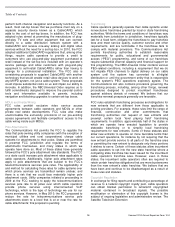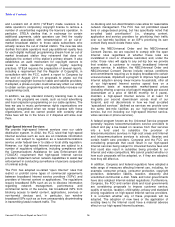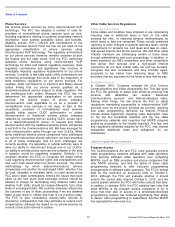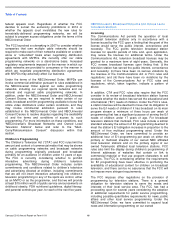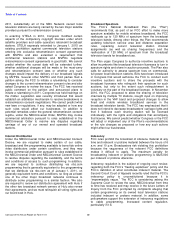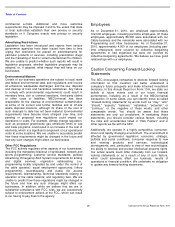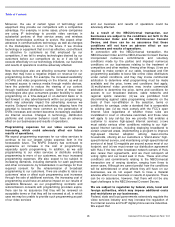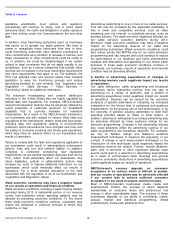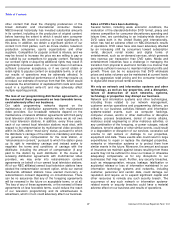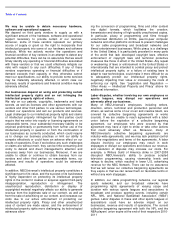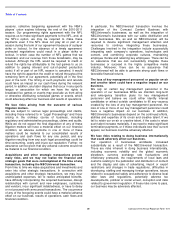Comcast 2010 Annual Report Download - page 27
Download and view the complete annual report
Please find page 27 of the 2010 Comcast annual report below. You can navigate through the pages in the report by either clicking on the pages listed below, or by using the keyword search tool below to find specific information within the annual report.
Table of Contents
Comcast 2010 Annual Report on Form 10-K
22
Other Areas of Regulation
Intellectual Property and Piracy
Copyright, trademark, unfair competition, patent, trade secret
and Internet/domain laws of the United States and other
countries help protect our intellectual property rights. In
particular, piracy of programming and films through
unauthorized distribution of counterfeit DVDs, peer-to-peer
file sharing and other platforms presents challenges for our
cable programming, broadcast and filmed entertainment
businesses. The unauthorized reproduction, distribution or
display of copyrighted material over the Internet or through
other methods of distribution, such as through devices,
software or websites that allow the reproduction, viewing,
sharing and/or downloading of content by either ignoring or
interfering with the content’s security features and
copyrighted status, interferes with the market for copyrighted
works and disrupts our ability to exploit our content. The
extent of copyright protection and the use of technological
protections, such as encryption, are controversial.
Modifications to existing laws that weaken these protections
could have an adverse effect on our ability to license and sell
our programming.
In October 2008, the Prioritizing Resources and Organization
for Intellectual Property Act of 2007 (the “PRO-IP Act”) was
signed into law in the United States. The PRO-IP Act
increases both civil and criminal penalties for counterfeiting
and piracy of intellectual property associated with works of
music and film (among others); provides enhanced resources
to law enforcement agencies for enforcing intellectual
property rights; criminalizes the exportation of counterfeited
goods; and creates an “Intellectual Property Enforcement
Coordinator,” a Senate-confirmed Presidential appointee
responsible for developing government-wide enforcement
policy, coordinating the enforcement efforts of U.S.
departments and agencies and coordinating the preparation
of a plan to reduce counterfeit and infringing goods in the
U.S. and international supply chain. In September 2010, the
Combating Online Infringement and Counterfeits Act was
introduced by the Senate Judiciary Committee. The bill would
give the Department of Justice the power to shut down
websites found to be offering infringing content by requiring
domain name registrars to suspend the domain names of the
offending sites and taking other actions to prevent third
parties from providing certain services to such sites.
While many legal protections exist to combat piracy, laws in
the United States and internationally continue to evolve, as
do technologies used to evade these laws. NBCUniversal
has actively engaged in the enforcement of its intellectual
property rights, and it is likely that we will continue to expend
substantial resources to protect our content. The repeal of
laws intended to combat piracy and protect intellectual
property or weakening of such laws or enforcement in the
United States or internationally, or a failure of existing laws to
adapt to new technologies, could make it more difficult for us
to adequately protect our intellectual property rights,
negatively impacting their value and further increasing the
costs of enforcing our rights.
Privacy and Security Regulation
The Communications Act generally restricts the
nonconsensual collection and disclosure to third parties of
cable customers’ personally identifiable information by cable
operators. There are exceptions that permit such collection
and disclosure for rendering service, conducting legitimate
business activities related to the service, and responding to
legal requests. The Communications Act also provides
privacy protections for customer proprietary network
information, or CPNI, related to our digital phone services.
Several states and the District of Columbia have enacted
privacy laws that apply to cable services.
The FTC has begun to exercise greater authority over privacy
protections generally, using its existing authority over unfair
and deceptive practices and other public proceedings to
apply greater restrictions on the collection and use of
personally identifiable and other information relating to
consumers. In December 2010, the FTC staff issued a draft
recommendation that privacy rules should address consumer
concerns over the collection and use of personal and profiling
information, even in the absence of demonstrated consumer
harm. In a December 2010 report, the Commerce
Department also suggested an expansion of privacy
protections, although with greater reliance on enforceable
industry codes. Legislation has also been introduced in
Congress that would regulate the use of personal and
profiling information for advertising. In addition, the FTC is
reviewing its implementation of the Children’s Online Privacy
Protection Act (“COPPA”). COPPA imposes requirements on
website operators and online services that are aimed at
children under 13 years of age, that collect personal
information from children under 13 years of age or that
knowingly post personal information from children under 13
years of age. The FTC is considering whether to expand the
reach of its COPPA rules to interactive TV and online
behavioral advertising; such changes, if adopted, could have
an adverse impact on our businesses to the extent our
networks and websites offer content targeted to children and
teens.
We are also subject to state and federal rules and laws
regarding information security. Most of these rules and laws
apply to customer information that could be used to commit
identity theft. Substantially all of the U.S. states and the
District of Columbia have enacted security breach notification
laws. These laws generally require that a business give
notice to its customers whose financial account information
has been disclosed because of a security breach. The FTC is
applying the “red flag rules” in the Fair and Accurate Credit
Transactions Act of 2003 to both financial institutions and
creditors, and we may be considered to be a creditor under
the FTC’s interpretation of the rules.
We are also subject to state and federal “do not call” laws
regarding telemarketing and state and federal laws regarding
unsolicited




